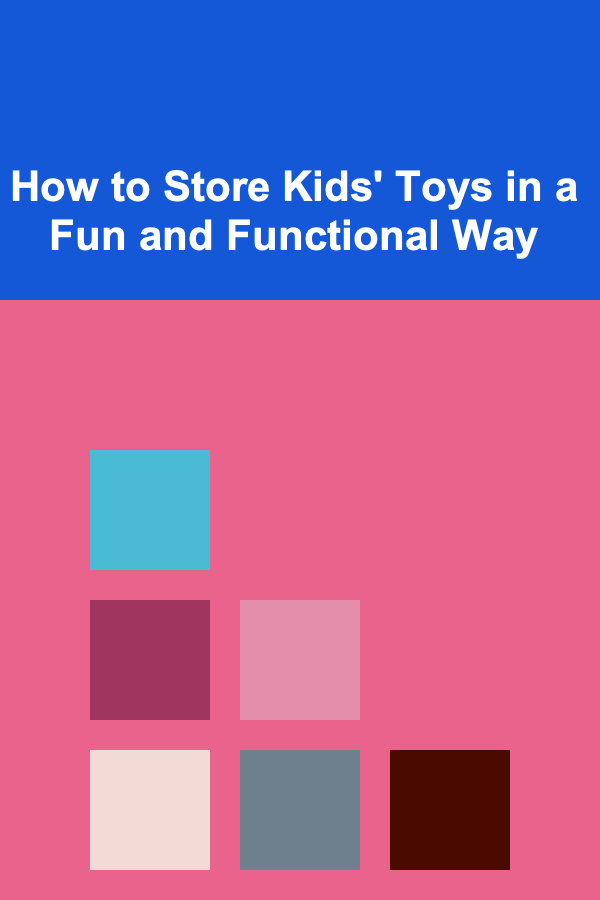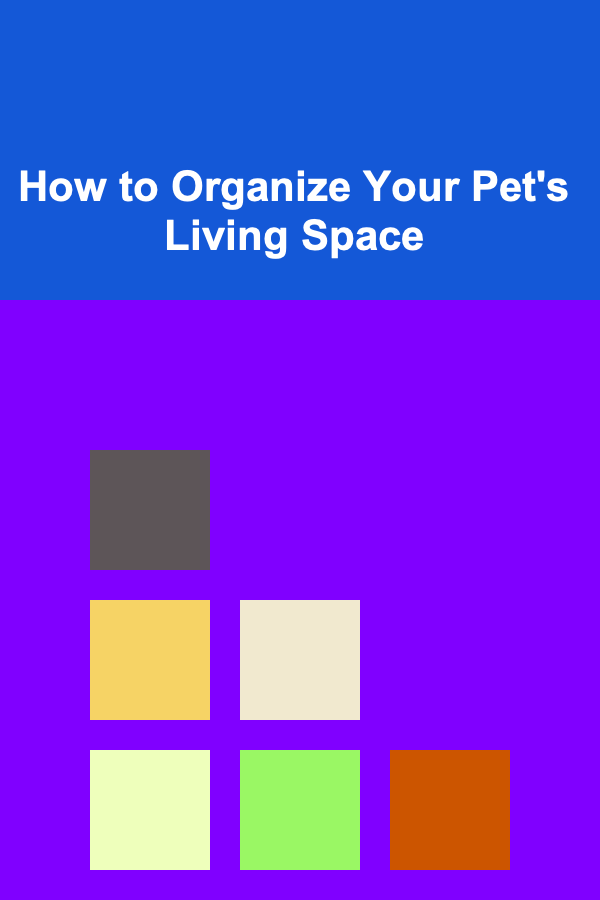
How to Store Kids' Toys in a Fun and Functional Way
ebook include PDF & Audio bundle (Micro Guide)
$12.99$5.99
Limited Time Offer! Order within the next:

As every parent knows, toys can quickly take over your home. From stuffed animals to action figures, building blocks to art supplies, kids' toys seem to multiply overnight. While having a variety of toys is essential for fostering creativity and learning, managing them can be a daunting task. If left unchecked, toys can create a cluttered and chaotic environment, making it difficult to maintain a clean, organized home.
However, organizing kids' toys doesn't have to be a chore. With a little creativity and some thoughtful planning, you can create a toy storage solution that's both fun and functional. In this article, we'll explore practical tips for storing toys in a way that's easy to maintain, encourages play, and enhances your home's aesthetic. From storage furniture to DIY solutions, we'll cover a range of options for keeping your child's toys organized while making sure the process feels enjoyable for both parents and kids.
Why Toy Storage Matters
Before diving into the best ways to store toys, it's important to understand why toy organization is crucial. An organized space promotes several benefits for both children and parents:
1. Promotes Responsibility
When children have designated spots for their toys, it encourages them to take responsibility for putting things away after use. This helps foster a sense of ownership and teaches them organizational skills early on.
2. Saves Time and Reduces Stress
Cluttered spaces can cause stress for both kids and parents. When toys are not stored properly, it's easy to lose track of favorite toys or spend valuable time searching for them. A well-organized toy storage system reduces this stress and saves time, making it easier to find the toys your child loves.
3. Creates a Safer Environment
When toys are left scattered around, it can create tripping hazards or make it difficult to navigate the room. Storing toys in an orderly way not only clears up floor space but also makes your home safer for everyone, especially for younger children.
4. Improves Playtime and Creativity
An organized toy area allows kids to easily access their toys and explore them without distractions. When toys are easy to find, it can spark creativity and help children engage more deeply in their play, whether they're building a Lego castle or drawing with crayons.
5. Boosts Aesthetic Appeal
A cluttered home can feel overwhelming, but when toys are neatly stored, it can create a more serene and inviting atmosphere. Well-designed toy storage solutions can blend into your home's décor, allowing your child's playthings to be both accessible and visually appealing.
Approaching Toy Storage with Fun in Mind
When organizing toys, it's essential to strike a balance between functionality and fun. After all, toys are meant to bring joy, so why not make the storage process enjoyable as well? Here are some ways to make storing toys a more fun experience for your child:
1. Incorporate Playful Designs
The storage containers and furniture you choose can add a playful element to the room. Look for colorful bins, baskets, or shelves that match your child's personality or the theme of the room. Bright colors, fun shapes, and whimsical designs can make the storage solutions feel like part of the playtime experience, rather than just a means to an end.
2. Create Interactive Storage Spaces
Engage your child in the toy storage process by making the storage space interactive. For example, you can set up a toy storage wall where your child has to place certain toys in designated spots, like a puzzle game. You can also use labeled bins or drawers to teach your child how to categorize toys, making the process educational and fun.
3. Turn Storage into a Game
Transform the act of cleaning up into a game. For example, you can time your child to see how fast they can put their toys away or create a scavenger hunt where they find specific toys to put back in their storage areas. Gamifying the storage process can make tidying up feel less like a chore and more like an enjoyable activity.
4. Involve Kids in the Process
Encourage your child to be involved in the organization process. Let them help choose their storage containers, and allow them to decide where their toys should go. This not only gives them a sense of control but also encourages them to take ownership of their space. It can be a bonding experience that fosters a sense of pride in their ability to keep things tidy.
Types of Toy Storage Solutions
There's no one-size-fits-all approach to toy storage. The best solution depends on the space available, your child's age, and the types of toys they have. Below are some popular storage solutions to help you create a functional and fun toy storage system:
1. Toy Bins and Baskets
One of the simplest and most versatile storage solutions is a collection of bins and baskets. They come in a variety of sizes, shapes, and materials, making them easy to customize for your needs. Here's how you can use bins and baskets effectively:
- Multi-Use Bins: Choose large, deep bins for storing bulkier toys like stuffed animals or balls. Small bins are perfect for organizing smaller toys, such as action figures, dolls, or building blocks.
- Color-Coded Bins: Use different colored bins for different types of toys. This can help children easily identify where each toy goes and can make tidying up a more engaging task.
- Lidded Bins: Lidded bins are great for keeping toys out of sight, especially when they're not in use. This can help maintain a tidy appearance in the room.
- Decorative Baskets: Choose decorative baskets that match the room's décor, and store them on shelves or in closets. Baskets with handles can make it easy for children to carry their toys from one place to another.
2. Toy Shelves and Racks
Shelves and racks offer open storage, allowing toys to be easily visible and accessible. Consider the following options for creating a practical and organized shelf system:
- Wall-Mounted Shelves: Use floating shelves to keep toys off the floor and create a visually appealing display. Small, shallow shelves work best for books, toys, or small figurines.
- Cubby Systems: Cubbies are an excellent way to organize toys in a more structured manner. Look for modular cubby systems that can be customized to fit your needs.
- Toy Racks: Toy racks or pegboards with hooks can store smaller toys, such as hats, dolls, or dress-up items. This makes it easy for kids to grab what they want without making a mess.
3. Storage Ottomans and Benches
Storage ottomans and benches serve as both seating and toy storage. They can be placed in the living room, playroom, or bedroom, and they offer a neat way to store toys while keeping the area clutter-free. Choose an ottoman with a removable lid to easily access stored toys.
- Built-In Storage: Many ottomans feature hidden storage beneath the seat, which can be ideal for storing toys. Some are even divided into compartments to help with organization.
- Seating + Storage: For multi-purpose use, select storage benches that can double as seating or a table. They're perfect for small spaces and can keep toys hidden when not in use.
4. Toy Chests and Trunks
Toy chests and trunks are classic storage solutions that can hold a large number of toys. They are particularly effective for storing bulkier toys, such as dolls, games, or sports equipment.
- Safety Features: Look for chests with soft-close lids or safety hinges to prevent fingers from getting caught.
- Fun Designs: Choose toy chests with fun and colorful designs that can add personality to the room. You can find chests shaped like cars, animals, or even castles.
- Personalized Chests: Personalizing a toy chest with your child's name can make it even more special and encourage them to keep their toys organized.
5. Rolling Carts and Trolleys
Rolling carts or trolleys are perfect for storing toys that are frequently used. With multiple levels and a wheeled base, these carts can be moved from room to room with ease.
- Portable Storage: Rolling carts can be moved around as needed, allowing you to quickly tidy up a play area when it's time for other activities. This flexibility is ideal for families with children of different ages.
- Compact Design: These carts often have a small footprint, making them ideal for apartments or smaller rooms. You can store art supplies, books, or smaller toys in a rolling cart for easy access.
6. Drawer Storage Systems
Drawer systems are another practical and space-efficient way to store toys. These can be placed under beds, in closets, or in playroom corners.
- Label Each Drawer: Use labels to categorize the toys, so your child can quickly find what they're looking for and know where to put things back.
- Under-Bed Drawers: If your child's bed has enough clearance, consider using under-bed storage drawers for toys that aren't used every day. This keeps toys out of sight and maximizes storage space in the room.
7. Hanging Organizers
Hanging organizers, such as pocket organizers or over-the-door racks, are an excellent way to store smaller toys, shoes, or accessories.
- Space-Saving: Hanging storage is great for maximizing vertical space. Use an over-the-door organizer to keep toys off the floor and save room for playtime.
- Clear Pockets: Clear pockets on hanging organizers make it easy to see what's inside, helping children quickly find their toys without pulling everything out.
Tips for Maintaining an Organized Toy Area
Once you've established a toy storage system, it's important to maintain the organization. Here are a few tips for keeping your child's toys tidy and accessible:
1. Establish a Routine
Make tidying up a part of your child's daily routine. Set aside time at the end of each day or after playtime for them to put away their toys. Turn it into a fun activity to make the process enjoyable.
2. Declutter Regularly
Go through your child's toy collection every few months and donate or dispose of toys they no longer use. This helps keep the toy area from becoming overcrowded and ensures your child only has the toys they truly enjoy.
3. Teach Organization Skills
Encourage your child to organize their toys by type or category. This can be a great learning opportunity, as they'll understand how to categorize items and develop better organizational habits.
4. Involve Your Child
Make your child a part of the decision-making process when it comes to toy storage. Let them help pick out storage containers or arrange the shelves. The more involved they are, the more likely they'll be to take ownership of the space.
5. Keep It Accessible
Ensure that toys are easy for your child to reach. Low shelves or bins at their height encourage independence and make it easier for them to play and clean up on their own.
Conclusion
Organizing kids' toys doesn't have to be a stressful task. With a combination of creative storage solutions and a little planning, you can keep toys neat and accessible while adding an element of fun to the process. Whether you opt for colorful bins, interactive storage systems, or creative shelving, the key is to create a space that works for both you and your child. By incorporating these ideas, you can foster a more organized and enjoyable environment, making playtime even more delightful.
Reading More From Our Other Websites
- [Home Party Planning 101] How to Host a Themed Party with Simple Decorations and DIY Ideas
- [Home Storage Solution 101] How to Build Your Own: DIY Garage Ceiling Storage Solutions for Under $100
- [Paragliding Tip 101] Soaring Shots: Mastering Camera Settings for High-Altitude Paragliding Photos
- [Organization Tip 101] How to Create a Post-Season Organization Ritual
- [Home Holiday Decoration 101] How to Set Up a Fun and Festive Holiday Photo Booth
- [Home Storage Solution 101] How to Make the Most of Under-Bed Storage for Clutter-Free Bedrooms
- [Organization Tip 101] How to Fix a Noisy Garage Door Opener
- [Home Cleaning 101] How to Sanitize Your Home's High-Touch Surfaces Regularly
- [Home Budget 101] How to Create Attainable Financial Goals for Families: From Short-Term Wins to Long-Term Wealth
- [Organization Tip 101] How to Adjust Portion Sizes for Individual Meal Prep

How to Identify Key Market Opportunities Using Data Analytics
Read More
How to Illuminate Your Home Office for Maximum Productivity
Read More
How to Keep Your Home's Electrical System Safe and Efficient
Read More
How to Organize Your Favorite Recipes for Quick Cooking
Read More
How to Organize Your Pet's Living Space
Read More
Top Tips for Saving Money on Extracurricular Activities for Kids Without Sacrificing Fun
Read MoreOther Products

How to Identify Key Market Opportunities Using Data Analytics
Read More
How to Illuminate Your Home Office for Maximum Productivity
Read More
How to Keep Your Home's Electrical System Safe and Efficient
Read More
How to Organize Your Favorite Recipes for Quick Cooking
Read More
How to Organize Your Pet's Living Space
Read More